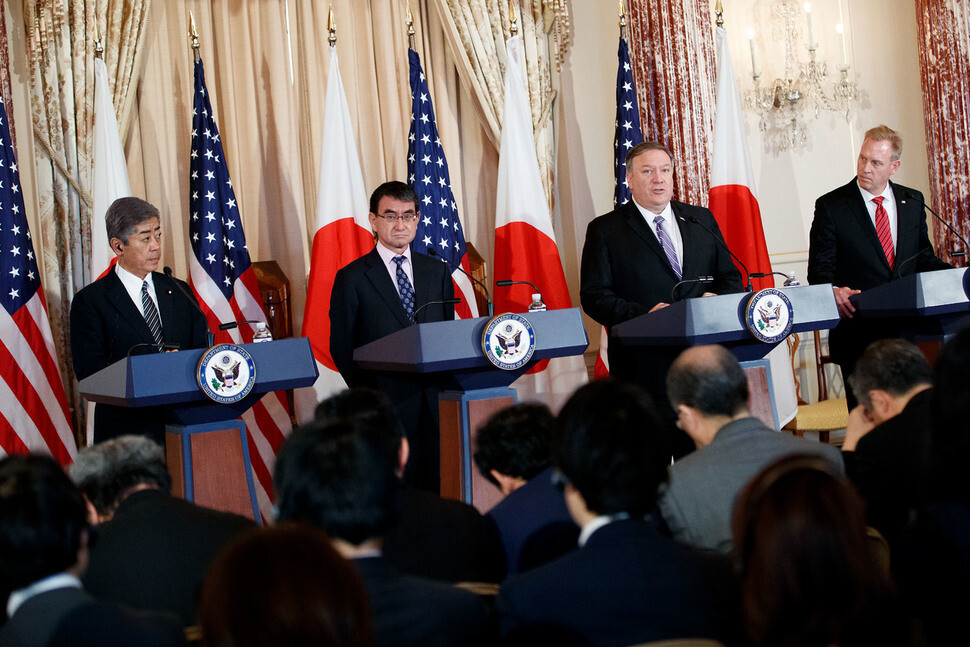hankyoreh
Links to other country sites 다른 나라 사이트 링크
US agrees to defend Japan from cyberattacks

For the first time, the US and Japan have interpreted Article 5 of their security treaty, which stipulates the US’ duty to defend Japan, as covering cyberattacks on Japan.
Following a “two plus two” meeting of the two countries’ top diplomats and defense officials on Apr. 19, the US-Japan Security Consultative Committee released a joint statement containing this interpretation.
“A cyberattack could, in certain circumstances, constitute an armed attack for the purposes of Article V of the US-Japan Security Treaty,” the two countries said in the joint statement. This was the first time that cyberattacks have been explicitly interpreted as being one of the attacks that could trigger Article 5 of the US-Japan Security Treaty.
“A decision as to when a cyberattack would constitute an armed attack under Article V would be made on a case-by-case basis, and through close consultations between Japan and the United States,” the statement added.
Japan and the US also addressed the issue of North Korea’s nuclear weapons and missiles in the statement, in which they “reiterated the importance of the international community’s ongoing commitment to achieving North Korea’s abandonment of all of its weapons of mass destruction, ballistic missiles, and related programs and facilities in a complete, verifiable, and irreversible manner in accordance with relevant UN Security Council resolutions.” While the joint statement signed in the 2017 “two plus two” statement had included language about North Korea’s “threat,” this word was omitted from this year’s statement, perhaps in consideration of the US’ continuing dialogue with the North.
Statement expresses “serious concern” about China’s naval aggression
The statement also “expressed serious concern about, and strong opposition to, unilateral coercive attempts to alter the status quo in the East China Sea (ECS) and South China Sea (SCS).” Though Japan and the US didn’t call out China by name, this did reconfirm that the raison d'être of their alliance consists of providing a counterbalance to China. The statement also declared for the first time that a “free and open Indo-Pacific” is a “shared vision” of the two countries.
The statement furthermore said that “the [Japan-US] Alliance’s technological advantage must be safeguarded from our adversaries at all times.” The Asahi Shimbun interpreted this as a reference to 5G mobile technology. The National Defense Authorization Act for Fiscal Year 2019, which was passed by the US Congress last year, banned US government agencies from using products by five Chinese companies, including Huawei. The US has asked its major allies to exclude equipment produced by Huawei while building a 5G mobile network, citing the risk of classified material being leaked. To date, the only major allies that have acceded to the US request are Japan and Australia.
By Cho Ki-weon, Tokyo correspondent
Please direct comments or questions to [english@hani.co.kr]

Editorial・opinion
![[Column] Season 2 of special prosecutor probe may be coming to Korea soon [Column] Season 2 of special prosecutor probe may be coming to Korea soon](https://flexible.img.hani.co.kr/flexible/normal/500/300/imgdb/original/2024/0426/3317141030699447.jpg) [Column] Season 2 of special prosecutor probe may be coming to Korea soon
[Column] Season 2 of special prosecutor probe may be coming to Korea soon![[Column] Park Geun-hye déjà vu in Yoon Suk-yeol [Column] Park Geun-hye déjà vu in Yoon Suk-yeol](https://flexible.img.hani.co.kr/flexible/normal/500/300/imgdb/original/2024/0424/651713945113788.jpg) [Column] Park Geun-hye déjà vu in Yoon Suk-yeol
[Column] Park Geun-hye déjà vu in Yoon Suk-yeol- [Editorial] New weight of N. Korea’s nuclear threats makes dialogue all the more urgent
- [Guest essay] The real reason Korea’s new right wants to dub Rhee a founding father
- [Column] ‘Choson’: Is it time we start referring to N. Korea in its own terms?
- [Editorial] Japan’s rewriting of history with Korea has gone too far
- [Column] The president’s questionable capacity for dialogue
- [Column] Are chaebol firms just pizza pies for families to divvy up as they please?
- [Column] Has Korea, too, crossed the Rubicon on China?
- [Correspondent’s column] In Japan’s alliance with US, echoes of its past alliances with UK
Most viewed articles
- 1Is Japan about to snatch control of Line messenger from Korea’s Naver?
- 2‘We must say no’: Seoul defense chief on Korean, USFK involvement in hypothetical Taiwan crisis
- 3Up-and-coming Indonesian group StarBe spills what it learned during K-pop training in Seoul
- 4[News analysis] Using lure of fame, K-entertainment agency bigwigs sexually prey on young trainees
- 5[Column] Park Geun-hye déjà vu in Yoon Suk-yeol
- 6Is N. Korea threatening to test nukes in response to possible new US-led sanctions body?
- 7Division commander ordered troops to enter raging flood waters before Marine died, survivor says
- 8S. Korea “monitoring developments” after report of secret Chinese police station in Seoul
- 9Will NewJeans end up collateral damage in internal feud at K-pop juggernaut Hybe?
- 10Report reveals toxic pollution at numerous USFK bases